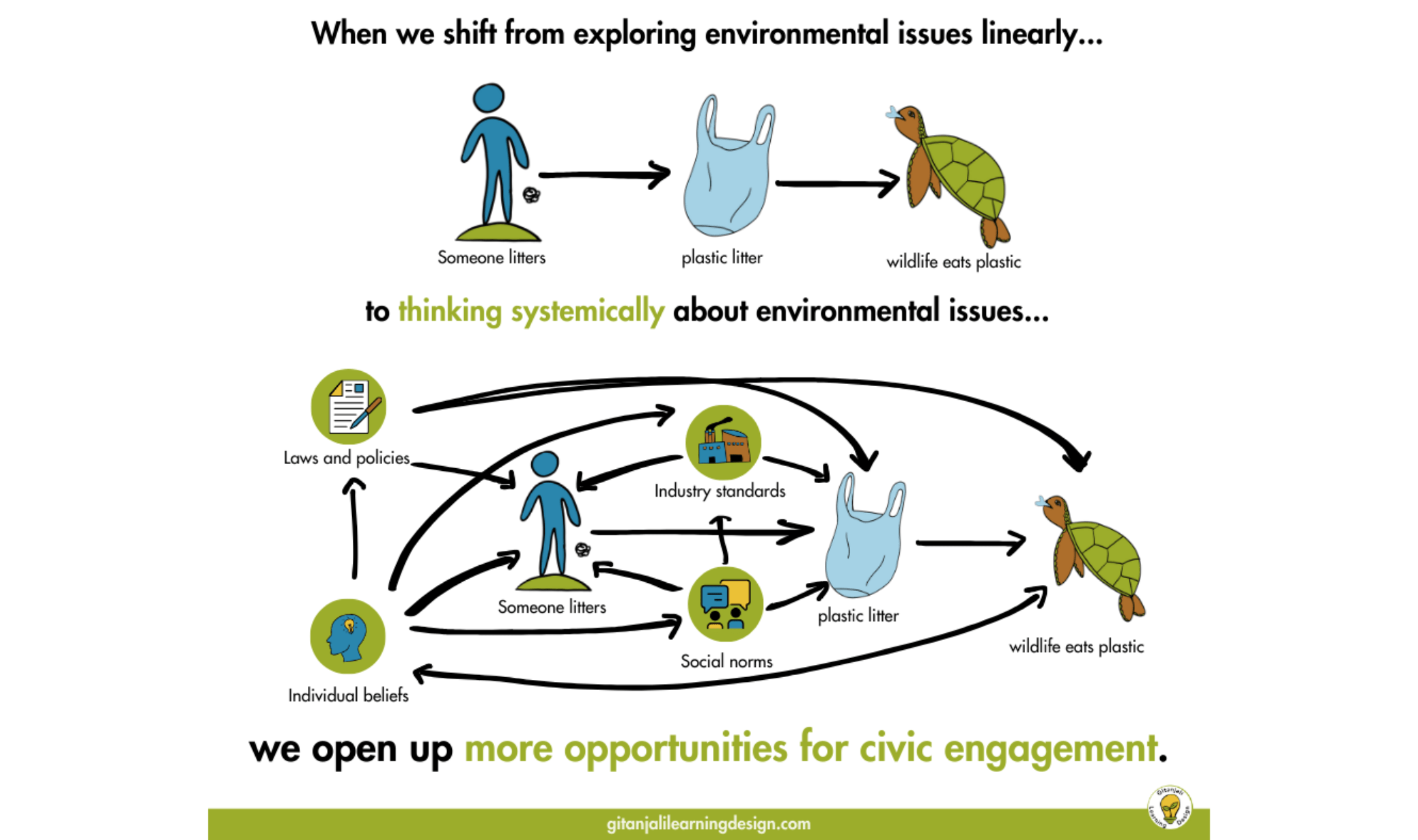Leveraging Systems Thinking to Further Civic Engagement for Sustainability

Welcome to our EE and Civic Engagement mini-blog series! This series highlights key insights from a panel discussion hosted by Cornell University and the NAAEE ee360+ program in May 2024. Each post will feature one panelist, sharing their segment of the webinar along with a thoughtful essay that expands on their ideas.
This essay is written by Gitanjali Paul, founder of Gitanjali Learning Design LLC. She specializes in helping organizations design and facilitate education for sustainable development. Her work emphasizes empowering individuals to think systematically to achieve transformative learning outcomes. Gitanjali is currently an NAAEE CEE-Change Fellow working with the nonprofit Compass Education to train PK-12 educators to integrate climate education and civic action into their classrooms with systems thinking tools.
Today’s youth are inundated with a torrent of systemic problems. As educators who want to engage youth in learning and action on pressing environmental challenges, how do we inspire a generation of knowledgeable, motivated, and civically engaged youth? This challenge was at the forefront of my mind when I started my career as a high school geography and history teacher career. While learning from the past and making sense of the present, I wondered how I could help my students understand the complex issues and engage them in making a difference in our community. One of the most powerful resources I gained was a systems thinking practice.
System thinking is a way of looking at the world that explores the dynamic interrelationships of the elements around us. Systems thinking can be a valuable lens for helping our students make sense of complexity—one of the 17 essential sustainability competencies young people need to achieve the UN Sustainable Development Goals, according to the team at the World’s Largest Lesson. This is one of the many reasons systems thinking can be an asset to engaging youth in environmental education and action. When students learn to make sense of the complex world around them and contextualize themselves in a system, they realize they can impact the world, not just be impacted by it. This helps students develop the knowledge, skills, and mindsets necessary to move away from apathy and eco-anxiety towards agency and hope.
When we explore environmental issues with students, it can be tempting to approach the problems linearly. If we see trash in the park, it’s because someone littered it. If we see plastic in the ocean, it’s because we use too many plastics. These types of ‘cause’ and ‘effect’ statements are true, but they’re also remarkably oversimplified. To make systems change, we must teach them to look beyond cause and effect to think about the systemic origins of environmental problems. This deeper reflection enables them to engage in more impactful civic action.

To make systems change, we must teach systems thinking. To teach systems thinking, we need systems thinking tools. Many systems thinking tools exist to help engage students in meaningful civic action to address environmental issues. The Sustainability Compass tool from the nonprofit Compass Education helps users make sustainable actions and decisions by reminding them to consider their actions through the lens of N (nature), E(economy), S(society), and individual W(wellbeing). The Systems Iceberg tool helps students dive deeper into the patterns and structures that lead to the events and problems they want to change in the world. It also helps them surface underlying mindsets and beliefs that inform our society and behaviors. Tools like causal loop diagrams help students make sense of the relationships in the world around them and tell compelling stories about how change is possible. All of these tools and more can help students visualize and engage with complex issues to identify their opportunities to make change.

Recognizing interdependence and dynamic relationships helps students understand how their actions can impact the systems around them. This allows them to practice anticipating the effects of their action plans to mitigate possible negative externalities so they can do the most good and the least harm. It also teaches the student to find leverage points - places in a system where they can maximize the impact of our limited time, energy, and resources by targeting them with our civic action. They can help students discover the depth of their influence and autonomy so they can focus their energy on a specific goal and targets.
Inspiring and empowering students to engage in civic education to address environmental issues is essential to have a genuinely positive impact and to ‘dive deeper’ into the environmental education system. But it’s not just students who need systems thinking training and tools. It’s us – educators. Whether we work in the classroom, community centers, museums, or the great outdoors, we are connected to dozens, if not hundreds, of students each year. That means if we develop and practice systems thinking in how we approach environmental issues and share our thinking and learning with the students or community members we work with, we can have an even more significant impact on cultivating a generation of empowered, engaged individuals. Systems thinking can help us develop our own leadership as environmental educators and reassert our agency as civically engaged human beings.

